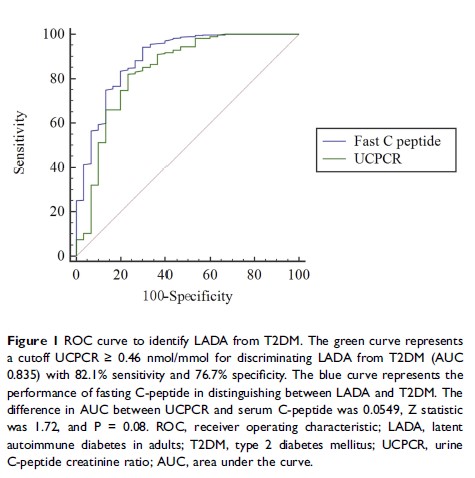100417
论文已发表
注册即可获取德孚的最新动态
IF 收录期刊
- 3.3 Breast Cancer (Dove Med Press)
- 3.4 Clin Epidemiol
- 2.5 Cancer Manag Res
- 2.9 Infect Drug Resist
- 3.5 Clin Interv Aging
- 4.7 Drug Des Dev Ther
- 2.7 Int J Chronic Obstr
- 6.6 Int J Nanomed
- 2.5 Int J Women's Health
- 2.5 Neuropsych Dis Treat
- 2.7 OncoTargets Ther
- 2.0 Patient Prefer Adher
- 2.3 Ther Clin Risk Manag
- 2.5 J Pain Res
- 2.8 Diabet Metab Synd Ob
- 2.8 Psychol Res Behav Ma
- 3.0 Nat Sci Sleep
- 1.8 Pharmgenomics Pers Med
- 2.7 Risk Manag Healthc Policy
- 4.2 J Inflamm Res
- 2.1 Int J Gen Med
- 4.2 J Hepatocell Carcinoma
- 3.7 J Asthma Allergy
- 1.9 Clin Cosmet Investig Dermatol
- 2.7 J Multidiscip Healthc

尿 C 肽肌酐比值作为鉴定成人隐匿性自身免疫性糖尿病(LADA)的一种非侵入性方法
Authors Liu W, Huang X, Zhang X, Cai X, Han X, Zhou X, Chen L, Zhang R, Gong S, Wang Y, Ji L
Received 3 September 2019
Accepted for publication 23 November 2019
Published 2 December 2019 Volume 2019:12 Pages 2531—2537
DOI https://doi.org/10.2147/DMSO.S229675
Checked for plagiarism Yes
Review by Single-blind
Peer reviewers approved by Dr Nicola Ludin
Peer reviewer comments 2
Editor who approved publication: Prof. Dr. Muthuswamy Balasubramanyam
Purpose: Latent autoimmune diabetes in adults (LADA) is a slowly progressing form of immune-mediated diabetes that combines phenotypical features of both type 2 diabetes mellitus (T2DM) and type 1 diabetes mellitus (T1DM), meaning that accurate and early diagnosis of this subtype of diabetes is critical for optimal long-term management. Urinary C-peptide creatinine ratio (UCPCR) represents a non-invasive and practical method for assessing endogenous insulin production to facilitate diabetes classification. However, no study to date has reported the use of UCPCR in identifying LADA.
Patients and methods: A total of 574 subjects were included in our study (42 LADA, 61 T1DM, 471 T2DM). All participants were evaluated for UCPCR and underwent clinical and laboratory evaluations. UCPCR was compared among different subtypes of diabetes using multinomial regression analysis, and a receiver operating characteristic (ROC) curve was used to identify its performance in diagnosing LADA.
Results: UCPCR was lower in LADA (0.4±0.6 nmol/mmol) compared with T2DM (1.2±0.9 nmol/mmol), but higher than in T1DM (0.2±0.3 nmol/mmol) (p<0.05). The association between UCPCR and LADA remained significant after adjusting for gender, age, age at diagnosis, body mass index, high-density lipoprotein cholesterol, and triglyceride (OR, 95% confidence interval (CI), 0.29 (0.09, 0.95)). The ROC curve revealed an area under the curve of 0.835 (95% CI (0.742–0.928), p<0.001). The cut-off point for UCPCR ≤ 0.46 nmol/mmol was 82.1% for sensitivity and 76.7% for specificity in the diagnosis of LADA.
Conclusion: UCPCR may represent a non-invasive, simple, and practical measurement of insulin secretion for early discrimination of LADA in routine clinical practice.
Keywords: autoimmune diabetes, urinary C-peptide, β-cell function, non-invasive measurement
